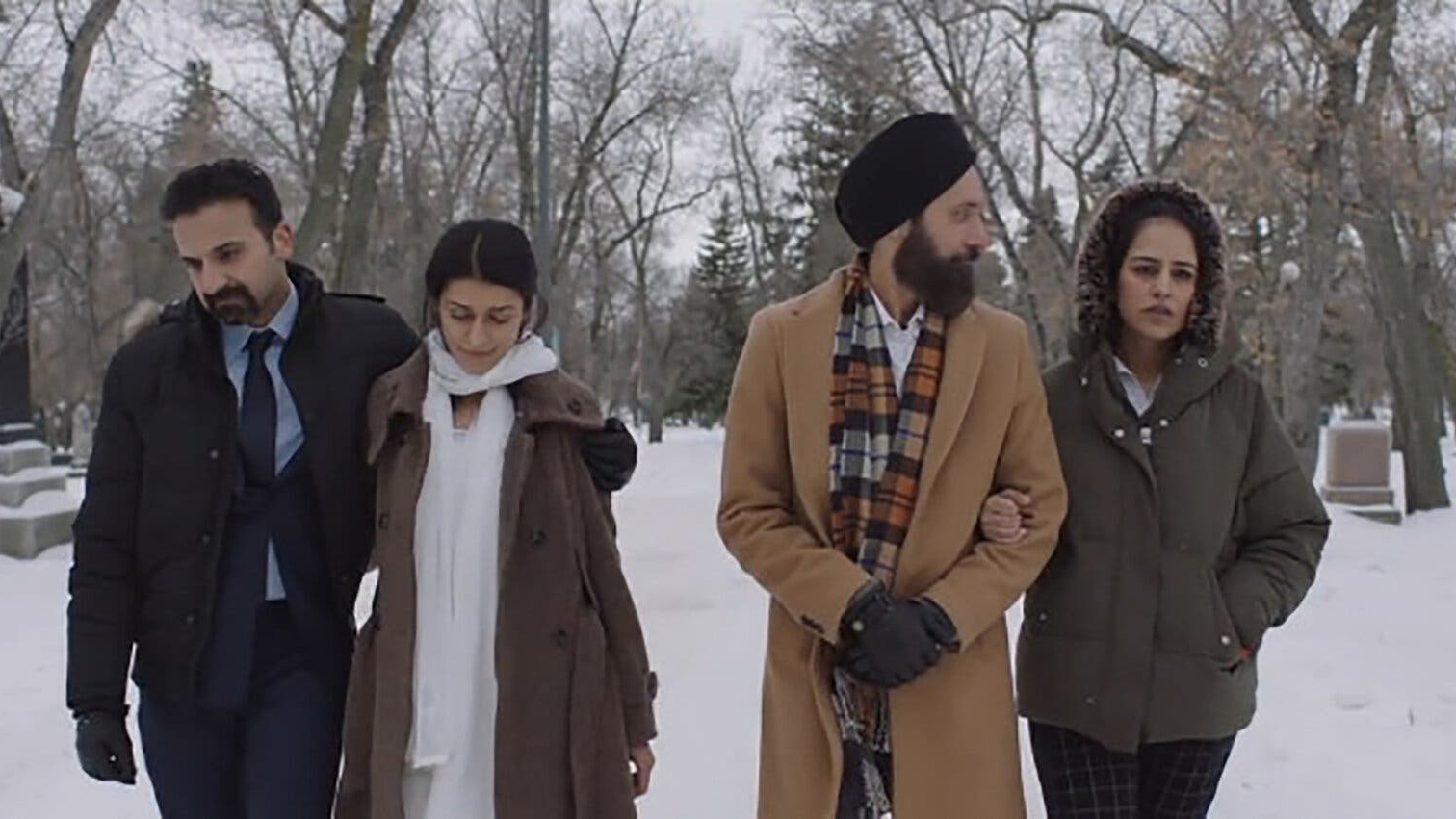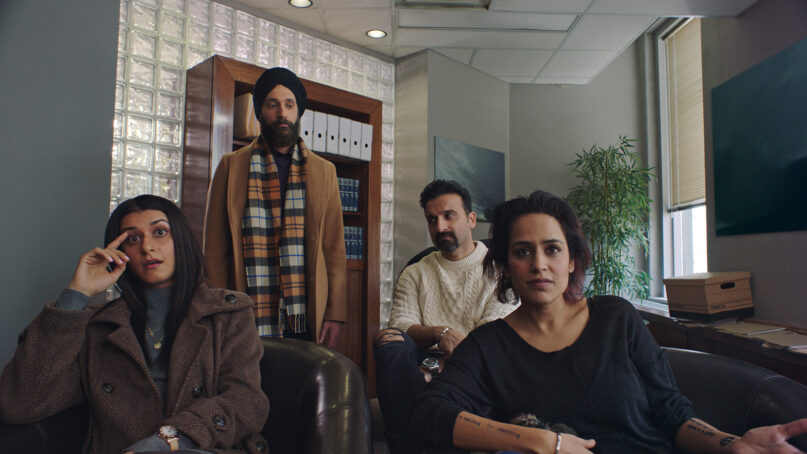(RNS) — It’s relatively uncommon to see South Asians on American screens, and it’s especially uncommon to see South Asian women. But some in the film industry are seeking to change that, including some filmmakers and production companies.
A December 2021 study from Nielsen found that while South Asian men are on the screen at a rate of 2.3% of the time, South Asian women only share the screen 0.3% of the time.
This is why so many South Asian Americans welcomed the news in January that Array Releasing, the distribution arm of Ava Duvernay’s narrative change collective, was acquiring two feature-length films by female South Asian directors: Sujata Day’s “Definition Please” and Agam Darshi’s “Donkeyhead.”
Though Day and Darshi did not know one another until their films were released, their works bear much in common: They draw from and depict authentic diasporic experiences; they explore challenging themes within South Asian American communities; and they break standard tropes, including the model-minority myth.
Both films also feature two triple-threats: Day and Darshi directed, produced and acted in their own films.
I had the opportunity to interview Agam Darshi about her process in writing and producing “Donkeyhead,” about a down-on-her-luck writer who is living with her declining Sikh father. When he suffers a stroke, her three siblings show up to blow up the life she’s retreated into. Our conversation below has been edited for length and clarity.
Tell us about why you felt moved to write this story and how it came together.
I’ve been an actor for a long time, and part of what moved me was wanting to create a film that represented and embraced the world that I know. I love indie family dramedy films, yet those families rarely look like my own. That was a big part of the push. I wanted to tell the story of a Sikh Punjabi family as I knew it.
I started writing it a long time ago, and over the course of writing it, the story started becoming more personal. For example, the father having cancer came in because I lived with my father while he was going through chemo.
I thought a lot about how I wanted to depict the main character, Mona. Getting that right was really important to me because I didn’t want to shy away from how so many Sikh women are living and feeling and behaving, or want to behave. I wanted to give her the kind of voice that’s so real, but is so often silenced, in real life and in how we share these stories with the world.

Huse Madhavji, from left, Sandy Sidhu, Stephen Lobo and Agam Darshi in “Donkeyhead.” Photo courtesy of Array
The character of Parm also felt really personal and important to me. I have a lot of Sikh friends who wear turbans, and most of the men in my family do, too. And I feel like they’re so misunderstood. It’s so vast. I have friends who are atheists who wear a pugg (turban); I know Sikh men who are gay; I know men who are womanizers; and (I have) Sikh friends who live according to the teachings. I wanted to be able to put some humanity into the image of a Sikh man.
Minoritized communities often worry about the optics of imperfection, and religious communities often get upset when they feel they’re being criticized. Was that on your mind when you were writing the film?
First and foremost, I wanted to make a film that I would be proud of, one that would satisfy me and my own sense of artistry. Being honest with myself and with the story was my top priority. At the same time, I have to say that I’m a part of this community and really care about it. A part of me was terrified about how the Sikh community would take it. I had people from within the community read the script and offer feedback. A lot of it was affirming, but there were definitely moments where people would say, “Agam, you can’t do that. You can’t talk about that.”
For example, making a turbaned Sikh character gay. I would reflect on that — what people cautioned me about and where that was coming from — and then I would make my decisions. It felt really important to me that Parm is gay, both because that’s the story I wanted to tell and because it felt real. That’s not something I was willing to take out just because people might not like it.
The way I see it, there’s a difference between the spiritual essence of Sikhism and the Punjabi culture. I’m realizing now in talking to you that what I wanted to do in this film is make a commentary on the culture. I see the teachings of Sikhism as harmonious and really beautiful, and I wanted to protect that. But I do have an issue with the culture, and that’s important, too.
In watching the film, those decisions feel so purposeful. Were there aspects of making this film that felt unexpected or surprising?
I realized while writing the script that it was a big responsibility to share a story from a community that’s not often known. But I don’t think I realized how invested I was in showing it (Sikhism) properly until I was in the process of making the film.
As an actor, I’ve been on sets where my husband was supposed to be Sikh, and he would wear a turban but didn’t have a beard, and I’d try to explain it to my producers and would get so frustrated that I couldn’t get through to them. It’s just tokenism, and I want no part in that. As minorities, we get so used to being tokenized, and we have come to accept it as being good enough — and it’s really not.
I thought a lot about how to depict the story with authenticity, and there were a few unexpected things that came up for me. We really wanted to show a “paath” (reading of Sikh Scripture), because that’s exactly what would happen in a Sikh household where someone’s so ill.
But to do that, I found myself insisting that we keep a certain amount of respect and sensitivity. We didn’t use a real Guru Granth Sahib (Sikh Scripture), because that didn’t feel right. We photocopied some pages and used different materials to make it look like a Guru Granth Sahib. Even though it wasn’t real, the whole cast and crew would take off their shoes out of respect, just like you would in a gurdwara.
I found myself really wanting to make details like that perfect. I recognize that for someone who’s not part of the culture, it just looks like a mound of material. But as a Sikh, I know that there’s a certain way of presenting it, so I was insistent that it be done the right way. I’m actually surprised by how important this was to me. Despite whatever the plot’s about, I realized my own love and pride in the Sikh religion through the process of creating this film.






